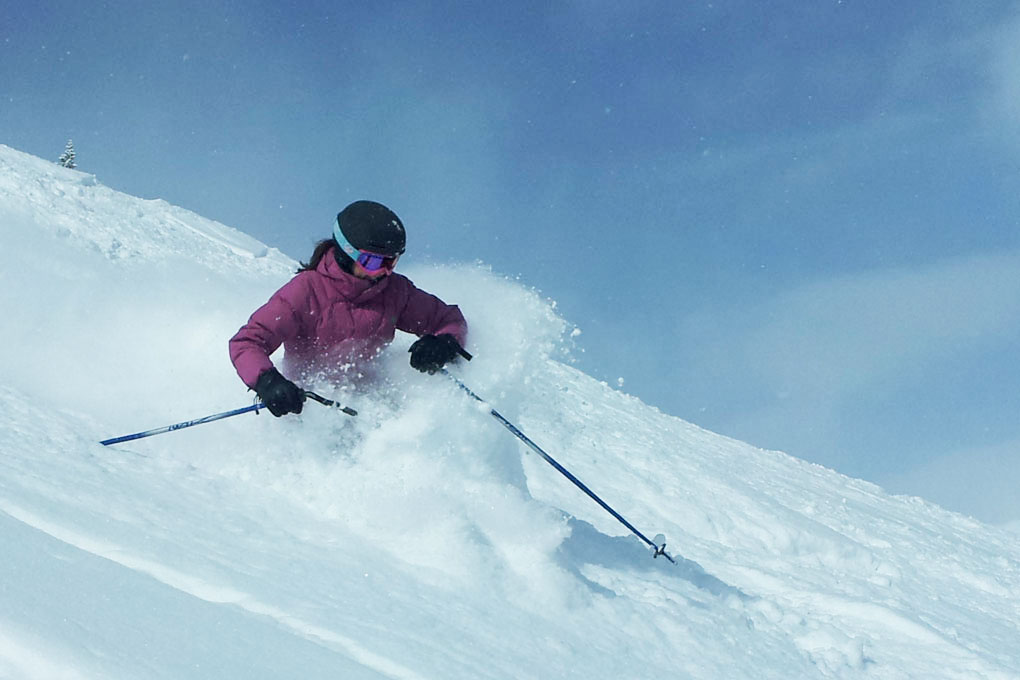Waterproof
When it comes to battling water, the Rockell uses a DWR (durable water repellant) and a two-layer Gore-Tex laminate.
I tested the Rockell on two really wet days, one at Park City Mountain Resort when it was raining, and the other at Alta, where wet snow was accumulating and melting on my outerwear while riding the chairlift.
At Park City, the chairs were soaked, so I was practically sitting in a puddle. Also, because I was teaching lessons, I never left the beginner lift, so I was not moving around to generate body heat.
On both days, I noticed the DWR did not completely repel liquid, in which case it would have caused water to bead up on the fabric’s surface. Instead, the outer nylon material absorbed some of the moisture, causing the material to appear wet. As a result, this moisture was theoretically blocking mass transfer, making the pants less breathable. Because the temperature was rather cold on both of these days, however, I was less concerned about breathability than I was about staying dry, and therefore warm. But in both cases, the Gore-Tex successfully prevented moisture from passing through to my under layers, allowing me to stay dry.
The pants weren’t noticeably heavier when I took them off at the end of those days either, despite sitting in puddles and skiing in the rain. The DWR allowed some moisture to be absorbed into the outer nylon layer, but a majority was repelled.
It is also important to note that the main area where I noticed this occurring was on the tops of my knees while riding the chairlift. This area seemed prone to this to happening because the material was tight against my thigh, so more heat was being released. As such, moisture tended to accumulate and soak into the outer material. It seems this was mostly due to the DWR wearing out slightly from normal wear and tear, and using a wash-in DWR treatment should help restore some of the water repellency.
Otherwise, the Rockell has fully taped seams and water resistant zippers at the hand pockets, and I did not notice any leaks on either of these wet days.
I will be interested to see how the Rockell performs this spring, in warm, wet conditions when it will be more important for the Rockell to be both breathable and waterproof. And I’ll be sure to update this post with any relevant information.
Warmth / Breathability / Venting
The Rockell is an insulated pant, which was appealing to me because I tend to run cold but love being warm. The pant is composed of an outer nylon material, two layers of Gore-Tex, and inner Thinsulate for insulation in certain areas.

SCOTT calls this Strategic Thermal Regulation (STR), in which the 80gr Thinsulate® is placed in cool areas (the back of the pant from the knees up, and the shins in front) and a performance mesh in warmer areas (the front of the thighs and the calves). The former works particularly well to keep your rear warm when sitting on a cold chairlift.
On below-freezing and windy days, the Rockell does a fantastic job of blocking the wind and keeping me warm. With my old pants, I used to wear long underwear and fleece pants on a daily basis, but besides a few of the extra cold days (temperatures below zero Fahrenheit), I only wear thin long underwear with the Rockell.
While the insulation is great in these colder conditions, it also means that at times I’ve been too warm in the Rockell pant, like when hiking or doing extensive side-stepping; skiing hard and nonstop on powder days; or teaching lessons on the magic carpet where I am literally running around, picking people up, and physically steering their skis. Granted, all of these situations involved increased exertion, but because the Rockell insulates so well, I found it difficult to cool down once I was overheated, and wished they had a bit more breathability or venting.
I love the Rockell because they are so warm, but the one change I’d personally like to see is the addition of vents for those rare occasions when I do get too hot.
Durability
I tend to be a little hard on anything I touch, so durability is especially important for me. Within days, runs, or minutes of having a new pair of snow pants, I almost always tear the pant cuffs with the edge of my skis. After 45 days wearing the Rockell, however, I am proud (and surprised) to say there is not a single rip in the pant cuffs. They are a little scuffed but not torn.
I also sometimes get a little too close to trees and catch my outerwear on branches. There are no tears in the Rockell, and all of the seams are intact.
I sacrificed my safety once to put the Rockell through a true durability test. I somehow managed to leave my poles under my leg when getting off the lift, and, after a sequence of events, I ended up hanging upside-down by the crotch of the Rockell on my ski poles. Needless to say, both ski poles broke, but both the Rockell and I are both still alive and in one piece.
Bottom Line
From my experiences in the Rockell, this pant is a fantastic option for women looking for a durable and insulated snow pant. Because there are no vents, however, I would not recommend this pant to anyone who gets hot super easily or is looking to do a ton of hiking or boot packing. Nonetheless, the Rockell is extremely comfortable and great option for layering without being too loose or sloppy.
